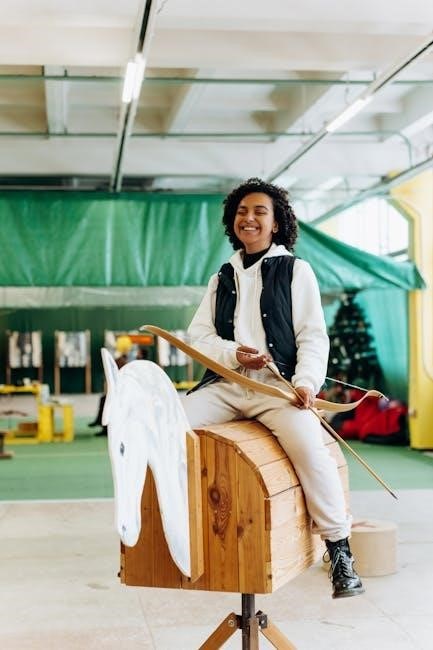
The Woman Warrior: An Overview
The Woman Warrior: Memoirs of a Girlhood Among Ghosts, penned by Maxine Hong Kingston, intertwines memoir and myth․ It explores the Chinese-American experience through the lens of female identity, family history, and cultural heritage․
Publication Details and Background
Maxine Hong Kingston’s groundbreaking memoir, The Woman Warrior: Memoirs of a Girlhood Among Ghosts, was first published in 1976 by Alfred A․ Knopf․ This seminal work quickly gained recognition for its innovative blending of autobiography, Chinese folk tales, and feminist perspectives․ Kingston, a first-generation Chinese American, delves into the complexities of cultural identity and the immigrant experience․
The book’s creation was a cathartic and emotional journey for Kingston, serving as a form of therapy for herself and her family․ It reflects her struggle to reconcile her Chinese cultural heritage with her American upbringing․ The memoir explores the challenges faced by women within Chinese culture, both in China and in the diaspora, and examines themes of oppression, silence, and the power of storytelling․ Through fragmented narratives and talk-stories passed down from her mother, Kingston weaves a rich tapestry of personal experience and ancestral myth․

Plot and Structure
The Woman Warrior unfolds in five interconnected chapters․ Each section blends personal narrative with Chinese “talk-stories,” exploring female adversity, cultural identity, and the power of storytelling within Kingston’s Chinese-American upbringing․
The Woman Warrior weaves together distinct narratives, each contributing to the overarching exploration of identity․ The No-Name Woman’s tragic tale highlights the silencing of female voices and the consequences of transgression․ Fa Mu Lan’s story embodies female empowerment and challenges traditional gender roles through mythical heroism․
Brave Orchid’s experiences in China showcase resilience and strength, while her interactions with Maxine reveal cultural clashes and generational differences․ Maxine’s struggle to reconcile her Chinese heritage with her American upbringing forms a central theme, highlighting the complexities of cultural assimilation and the search for self-definition․ The memoir delves into themes of oppression, cultural expectations, and the transformative power of storytelling․ Kingston confronts racism, sexism, and cultural barriers, ultimately forging her own identity through a blend of personal experience, family history, and reimagined myths․ The blurred lines between reality and fantasy emphasize the subjective nature of memory․
The Blending of Memoir and Myth
Kingston masterfully interweaves personal memoir with traditional Chinese “talk-stories” and myths, creating a unique narrative tapestry in The Woman Warrior․ This blending of genres blurs the lines between reality and fantasy, reflecting the way stories are passed down through generations, often embellished and transformed in the process․ The mythical elements, particularly the tale of Fa Mu Lan, serve as powerful metaphors for female empowerment and resistance against societal constraints․
These myths provide Kingston with a framework to explore her own experiences as a Chinese-American woman, allowing her to reimagine her identity and challenge traditional expectations․ The talk-stories, often shared by her mother, become a way to connect with her cultural heritage and understand the experiences of the women who came before her․ However, Kingston also questions and reinterprets these stories, asserting her own voice and agency in shaping her narrative; The blending of memoir and myth underscores the subjective nature of memory and the power of storytelling to shape our understanding of ourselves and the world around us․

Character Analysis
The Woman Warrior presents a rich cast of characters, real and mythical, whose stories illuminate themes of identity, cultural heritage, and the challenges faced by women in Chinese and American societies․
Maxine Hong Kingston: Author and Narrator
Maxine Hong Kingston is both the author and narrator of The Woman Warrior, offering a deeply personal and introspective account of her experiences as a first-generation Chinese-American woman․ Through her narrative voice, Kingston explores the complexities of her cultural identity, grappling with the expectations and traditions of her Chinese heritage while navigating the realities of American society․
As the eldest of six children, Kingston’s experiences shape her perspective, influencing her understanding of family dynamics and the roles assigned to women within her community․ Her narrative voice blends memoir, personal reflection, and Chinese “talk-stories”, blurring the line between reality and fantasy․
Through writing The Woman Warrior, Kingston finds a form of catharsis and emotional release, using her experiences to explore themes of identity, oppression, and the power of storytelling․ Her narrative voice resonates with authenticity and vulnerability, inviting readers to engage with her experiences and contemplate the broader issues of cultural identity and female empowerment․
Brave Orchid: Mother and Storyteller
Brave Orchid, Maxine Hong Kingston’s mother, plays a pivotal role in The Woman Warrior, serving as both a central figure in Kingston’s life and the primary source of the “talk-stories” that shape the narrative․ Brave Orchid embodies the strength and resilience of Chinese immigrant women, having faced numerous hardships and challenges in her journey to America․
As a storyteller, Brave Orchid transmits cultural knowledge and familial history to Kingston, sharing tales of mythical warriors, ancestral traditions, and the struggles of women in Chinese society․ These stories, while often fantastical and embellished, serve as a means of both preserving cultural heritage and imparting moral lessons․
However, Brave Orchid’s storytelling is not without its complexities․ Her narratives often reflect the patriarchal values and expectations of Chinese culture, creating tension and conflict within Kingston as she grapples with her own identity and aspirations․ Despite this, Brave Orchid’s influence on Kingston is undeniable, shaping her understanding of womanhood, family, and the power of storytelling․
No-Name Woman: The Silenced Aunt
The “No-Name Woman,” Kingston’s paternal aunt, is a haunting presence in The Woman Warrior, representing the consequences of female transgression and the silencing of women’s voices in traditional Chinese society․ Her story, revealed to Kingston through her mother’s cautionary tale, centers on an act of adultery that leads to her ostracization and ultimate demise․
The aunt’s anonymity underscores her erasure from the family’s history, highlighting the patriarchal structures that condemn and punish women for deviating from societal norms․ Kingston grapples with the ambiguity surrounding her aunt’s actions, questioning whether she was a victim of circumstance or a willful rebel․
The No-Name Woman’s silence becomes a symbol of the constraints placed upon women in Chinese culture, where their voices are often suppressed, and their stories are left untold․ Kingston’s attempt to reconstruct her aunt’s narrative is an act of reclaiming her voice and challenging the forces that seek to silence women․ The aunt’s tragic fate serves as a reminder of the dangers of female defiance in a patriarchal society․
Fa Mu Lan: The Mythical Warrior
Fa Mu Lan, the legendary Chinese warrior woman, serves as a potent symbol of female empowerment and defiance in The Woman Warrior․ Kingston reimagines the traditional Mu Lan narrative, imbuing it with her own experiences as a Chinese-American girl struggling to find her voice and identity․
Kingston’s Fa Mu Lan is not merely a skilled fighter but also a figure who challenges patriarchal norms and defies expectations․ She embodies the potential for women to transcend societal limitations and achieve greatness in a world that seeks to confine them․
The Mu Lan narrative provides Kingston with a framework for exploring themes of courage, self-discovery, and the power of storytelling․ Through her reimagining of the myth, Kingston creates a space for female agency and celebrates the strength and resilience of women․ Fa Mu Lan’s warrior spirit inspires Kingston to embrace her own voice and fight against the forces that seek to silence her․ The mythical warrior becomes a role model, a symbol of hope, and a testament to the transformative power of female empowerment․

Themes and Interpretation
The Woman Warrior delves into themes of identity, cultural heritage, and the power of storytelling․ It examines the oppression of women and explores the complexities of being a Chinese-American in a society․
Identity and Cultural Heritage
Maxine Hong Kingston’s The Woman Warrior profoundly explores the intricate intersection of identity and cultural heritage for Chinese-Americans․ As a first-generation immigrant, Kingston grapples with reconciling her Chinese cultural roots with her American upbringing․ The memoir delves into the challenges of navigating two distinct cultural landscapes, each with its own set of expectations and values․
Kingston’s narrative reveals the tension between honoring traditional Chinese customs and embracing American individualism․ She confronts the pressure to conform to societal norms while simultaneously preserving her family’s history and heritage․ Through vivid storytelling and personal anecdotes, Kingston illuminates the complexities of cultural assimilation and the search for a sense of belonging․ Her experiences reflect the broader struggles faced by many immigrants as they navigate the complexities of cultural identity in a new land․ The book is considered a reflection of her family’s history․
The Power of Storytelling
In The Woman Warrior, Maxine Hong Kingston masterfully showcases the profound power of storytelling as a means of shaping identity, preserving cultural heritage, and challenging societal norms․ Through the weaving of “talk-stories” passed down through generations, Kingston explores the ways in which narratives can both empower and silence individuals, particularly women․
Her mother, Brave Orchid, serves as a key figure in this exploration, sharing stories of mythical warriors and ancestral struggles that shape Kingston’s understanding of her heritage and her place in the world․ These stories provide a framework for understanding the complexities of being a Chinese-American woman, offering both inspiration and cautionary tales․ Kingston’s own act of writing becomes a form of storytelling, allowing her to reclaim her voice, challenge the silences imposed upon women, and forge her own identity through the power of narrative․ It is a cathartic and emotional experience․
Feminism and the Oppression of Women
The Woman Warrior is often considered a significant feminist text, deeply examining the multifaceted oppression of women within both Chinese and American cultures․ Maxine Hong Kingston unveils the systematic silencing and belittlement of women through various “talk-stories” and personal experiences․ The narrative exposes how traditional expectations and societal norms restrict women’s agency, self-expression, and opportunities․
Kingston confronts the sexism inherent in her upbringing, challenging the criticisms and limitations imposed upon her by her mother and community․ She explores the struggles of women like No-Name Woman, who are punished for transgressing social boundaries, highlighting the severe consequences of female defiance․ Through the figure of Fa Mu Lan, Kingston presents a powerful symbol of female empowerment, yet also acknowledges the challenges and sacrifices required to break free from patriarchal constraints․ The memoir underscores the need for women to reclaim their voices and resist the forces that seek to diminish their worth․

Critical Reception and Legacy
The Woman Warrior garnered critical acclaim for its innovative blend of memoir and myth․ It’s celebrated for its exploration of cultural identity and feminist themes․ The book has left a lasting mark on literature․
Influence on Literature
Maxine Hong Kingston’s The Woman Warrior has exerted a profound influence on literature, particularly within Asian-American and feminist studies; Its innovative blending of memoir, myth, and Chinese talk-stories paved the way for other writers to explore themes of identity, cultural heritage, and the immigrant experience in unique ways․ The book’s exploration of female voices, often silenced or marginalized, resonated deeply with feminist readers and writers, inspiring further examination of women’s roles and experiences across cultures․
Kingston’s work challenged traditional narrative structures, encouraging experimentation with form and voice․ Her impact can be seen in the increased representation of Asian-American perspectives in literature and the growing recognition of the complexities of bicultural identity․ The Woman Warrior has become a cornerstone of college curricula․